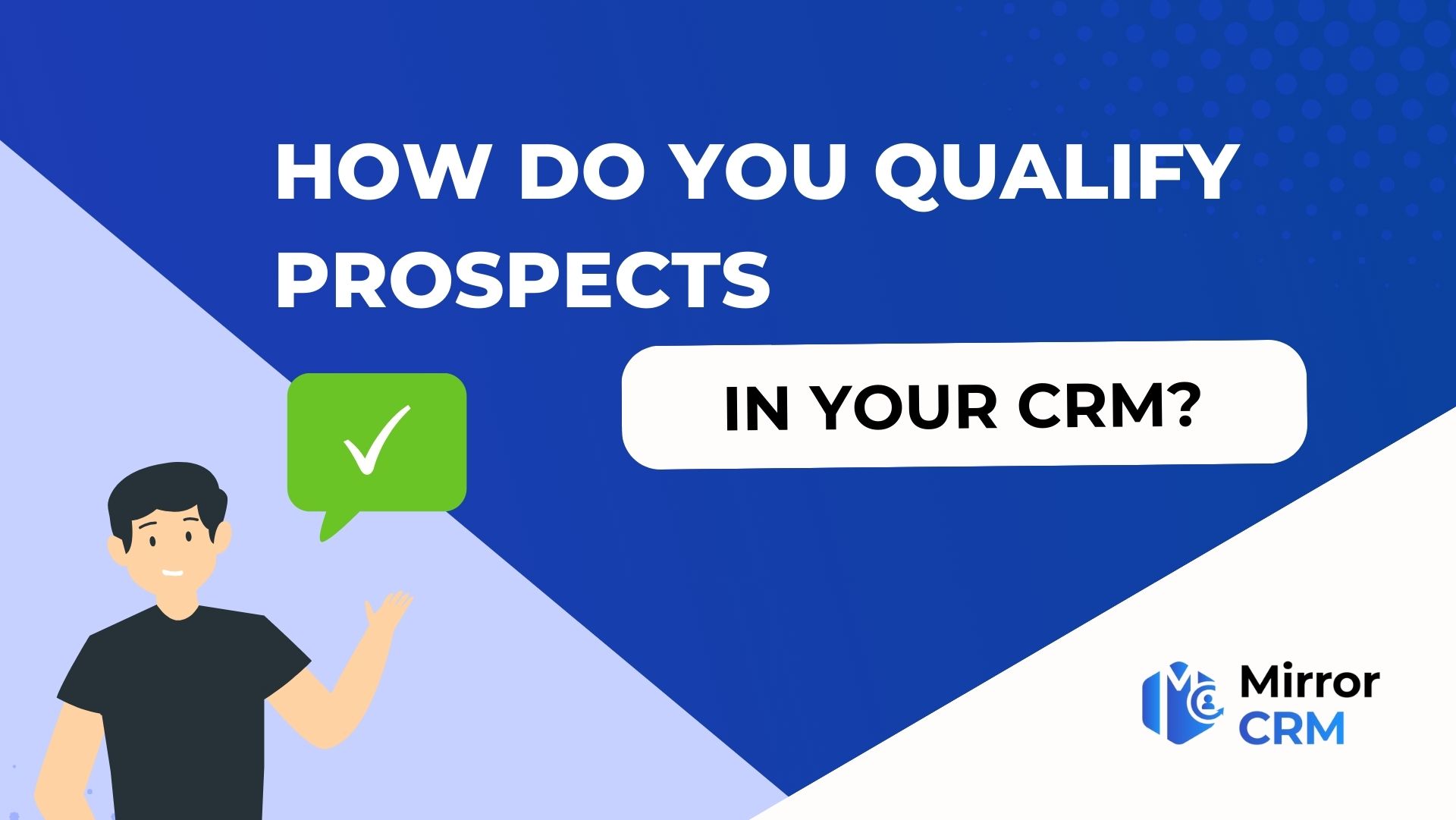Introduction
Qualifying prospects is a decisive step in developing an effective sales strategy, enabling companies to accurately target the most promising opportunities. This process is based on a detailed analysis of available information, ranging from professional characteristics to online behavior, in order to distinguish the prospects most likely to convert into leads. By adopting innovative tools such as CRM systems and pre-CRM solutions like MirrorCRM, companies can optimize their prospecting efforts, ensuring a more personalized and effective approach to prospect engagement.
What is lead qualification?
Qualifying prospects is a crucial process that enables companies to prioritize and optimize their prospecting efforts. This involves evaluating and ranking prospects according to their potential value to the company and the risk associated with turning them into paying customers.
Prospect ranking is based on a detailed analysis of the information available on each prospect, including demographic data, previous interactions with the company and online behavior. The aim is to distinguish hot prospects, those who show a marked interest in the company’s products or services and are ready to make a purchase, from lukewarm or cold prospects, who require further commitment before they can be considered viable sales opportunities.
To carry out this process, companies often use customer relationship management (CRM) systems. These systems aggregate and analyze prospect information from a variety of sources, including social network interactions, website visits and responses to e-mail marketing campaigns. By integrating this data into a CRM, companies can automate the creation of task lists for their sales teams, telling them which prospects to contact first and which messages to use to maximize the chances of becoming a customer.
Qualifying prospects in a CRM not only saves time and increases team efficiency, but also enables personalized interactions with prospects. By better understanding where each prospect is in the buying journey, a salesperson can tailor his or her approach to address each person’s specific needs and concerns, thus increasing the chances of successful prospecting.
In short, prospect classification is an essential step in a company’s sales approach. Thanks to tools like MirrorCRM, companies can optimize this process, ensuring a targeted, personalized approach that translates into better conversion of prospects into leads.
Why qualify prospects in your CRM?
Qualifying prospects within your customer relationship management (CRM) system is of vital importance in refining your company’s sales techniques and making them more effective. This involves evaluating each prospect to determine his or her potential for conversion into a customer, enabling you to concentrate your efforts where they will be most fruitful. A CRM is designed to collect information on leads and customers, not prospects. This is why, in this case, prospect qualification must be carried out in a MirrorCRM-type Pre-CRM.
One of the main benefits of lead qualification in pre-CRM is optimized resource allocation. By identifying the most promising prospects, you can allocate your time and budget more strategically, focusing on the interactions that are most likely to generate sales. This not only helps increase campaign ROI, but also reduces the time and costs associated with chasing less qualified leads.
Qualifying prospects also contributes to better collaboration between sales and marketing teams. With a clear, shared view of the most qualified prospects, these teams can work together to develop targeted, consistent methods, from lead generation through to final conversion. This creates synergy between sales and marketing efforts, leading to increased efficiency and better overall results.
What’s more, by qualifying prospects, you can personalize your messages even further. By understanding each prospect’s needs, interests and stage in the buying journey, sales teams can tailor their message to better resonate with each individual. This tailored approach increases the chances of engagement, as it demonstrates a deep understanding of the prospect’s specific challenges and needs.
Last but not least, integrating lead qualification into your pre-CRM helps you to continuously improve your sales processes. By analyzing the performance of different prospect categories over time, you can fine-tune your qualification requirements and prospecting strategies to better respond to market developments and the changing needs of your target customers.
In short, lead qualification in a pre-CRM is an essential practice that enables sales efforts to be targeted more effectively, interactions with prospects to be personalized, collaboration between teams to be strengthened, and techniques to be continually optimized for improved results.
How do I qualify my prospects in my CRM?
To effectively qualify your prospects in your CRM, it’s essential to implement a structured method that takes into account various relevant criteria. Here are some key methods and examples to illustrate how you can qualify your leads:
1. Categorize leads by acquisition channel and by targeting
Start by identifying the channels through which prospects have been acquired. Linkedin / Emaling / Call / offline and online events. For example, leads from social networks may have different needs to those from email campaigns. A prospect who responded to a campaign on LinkedIn might be interested in professional solutions, while a lead generated by a Facebook ad might be attracted by a more community or educational aspect of your offering.
2. By hierarchical level
Take into account the contact’s hierarchical position within the company. Key decision-makers, such as directors or senior executives, might require a direct, personalized approach, while mid-level contacts could be cultivated through nurturing campaigns. For example, in B2B sales, a purchasing manager might be approached directly with sales proposals, while a technician might be engaged with detailed technical content.
By integrating these qualification techniques into your MirrorCRM, you can not only personalize your interactions with each prospect, but also optimize your sales process by focusing your efforts on the most promising leads.
3. Categorize leads by geographic origin
A prospect’s location can influence his or her needs and purchasing decisions. A potential customer located in a dense urban area may have different concerns from those of a prospect in a rural area. For example, a company offering logistics solutions could segment its prospects according to their proximity to major logistics centers or seaports. In another case, if your average B2B shopping basket is high, it might be worth sending a field sales rep to make a presentation.
4. Qualification by business challenge
Identify prospects according to their profitability potential. High-growth companies or high-value industries can be classified as high-priority leads. For example, a software supplier might identify early-stage technology companies as key prospects, as they may require scalable and innovative solutions.
5. Organize leads according to desired offer
Segment your prospects according to the importance they attach to your different products or services. If you offer a range, a prospect interested in a high-end product might be classified differently from one interested in a more economical option. For example, a travel agency could distinguish between customers interested in luxury holidays and those looking for low-budget adventures.
6. Classify according to lead scoring
Use a lead scoring system to evaluate each prospect’s engagement, awarding points for different actions (website visit, content download, webinar participation). A prospect reaching a certain score could be considered ripe for sale. For example, a software publisher might award extra points to prospects who have downloaded a trial version or viewed a product tutorial.
With MirrorCRM, this lead scoring is automated, just for your information 😉
Using Pre CRM
The use of a Pre-CRM, such as MirrorCRM, is revolutionizing the way companies approach the qualification and pre-selection of their leads. By positioning itself as an indispensable tool even before prospects enter the sales pipeline, MirrorCRM offers several notable advantages:
1. Refining the prospect selection process
MirrorCRM considerably refines the prospect selection process, ensuring that only the most relevant and promising prospects reach the lead stage. Thanks to a lead scoring system, your team can focus exclusively on prospects who show a real commitment to your services, optimizing sales efforts and increasing the chances of conversion.
2. Targeted, effective approach
With MirrorCRM, sales prospecting becomes a much more targeted and efficient task. By pre-filtering prospects according to specific criteria, you ensure that your sales efforts are concentrated where they are most likely to produce positive results, making every interaction more relevant and personalized.
3. Manage your prospecting files
MirrorCRM offers complete control over your files, giving you total control over how your prospect data is managed and segmented. Indispensable when using automated prospecting tools. Once a prospect has been turned into a lead, you can transfer it to your CRM.
4. Key features and automation
In just a few clicks, and thanks to pre-designed templates, you can set up personalized, automatic message sequences. From the organization and pre-selection of leads to the automatic allocation of sales reps, every step is designed to optimize workflow and minimize manual effort.
5. Integration with other prospecting tools
One of MirrorCRM’s major assets is its ability to integrate seamlessly with other existing tools and CRMs, such as HubSpot. This interconnectivity ensures a smooth transition of qualified prospects from MirrorCRM to your main CRM, where they become leads and can be managed and nurtured through to conversion.
6. Intelligent TODO and automatic generation
Thanks to over 10 years’ experience in prospecting, we have developed an automated system for lead scoring and follow-up. The 2 together create a daily to-do list for your sales rep. Of course, these TODOs can be individual or collective.
In short, MirrorCRM transforms the way companies approach lead qualification, offering an intuitive and powerful pre-CRM platform that sharpens the lead selection workflow, makes prospecting more efficient and maximizes the effectiveness of sales teams through a series of intelligent automations and integrations.
Conclusion
In conclusion, mastering the classification and qualification of prospects within a pre-CRM is fundamental to refining sales strategies. Understanding the value and potential of each prospect enables companies to focus their resources more effectively, targeting interactions that offer the best chance of conversion.
Introducing a pre-CRM tool like MirrorCRM into the lead qualification process marks a significant evolution in the management of your customer acquisition tunnel. By refining the selection process even before leads enter the sales pipeline, MirrorCRM enables sales teams to focus on the most qualified prospects, optimize the use of their customer files, and benefit from automation features that simplify and accelerate campaigns.
With key features such as easy integration with other tools and existing CRMs, MirrorCRM is positioned as an essential complement to traditional CRM, offering a more targeted and effective approach to sales prospecting. This pre-CRM tool not only transforms the way prospects are managed before entering the sales pipeline, but also improves the overall efficiency of sales teams thanks to its automation and organization capabilities.
In an increasingly competitive market, adopting innovative tools like MirrorCRM can provide companies with the control tower they need to stand out from the crowd, ensuring more accurate lead management and transforming sales prospecting into a more strategic, results-oriented process.




